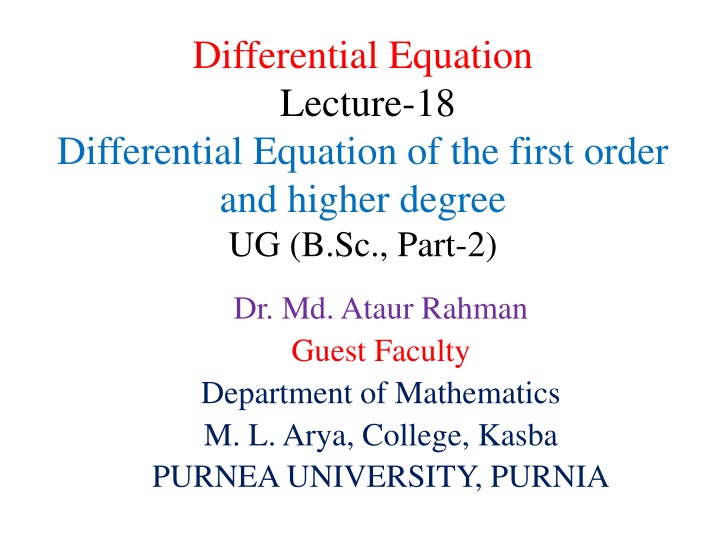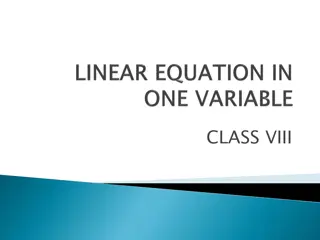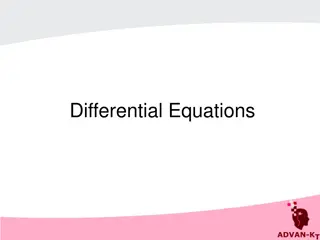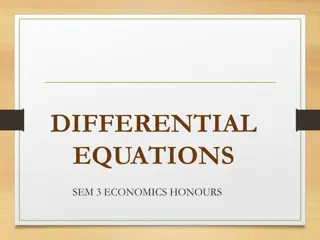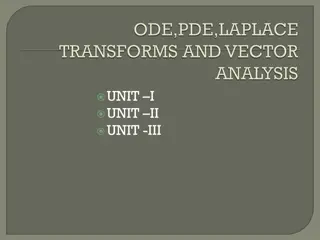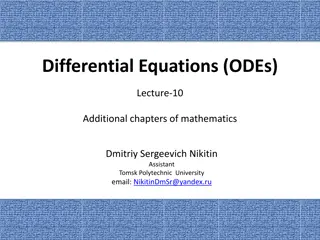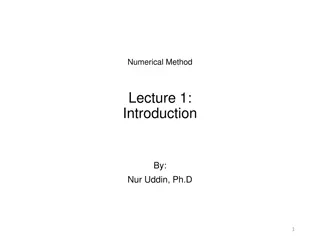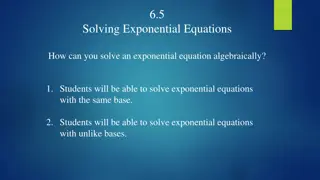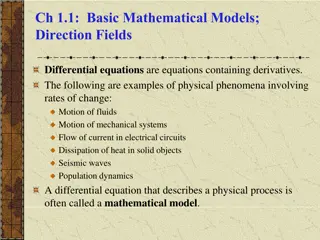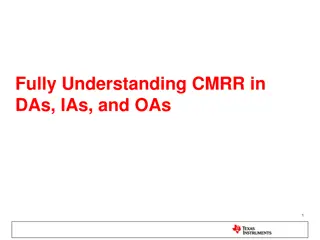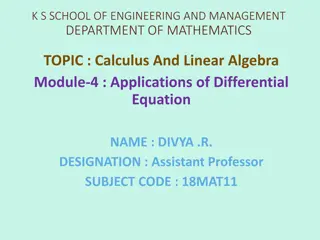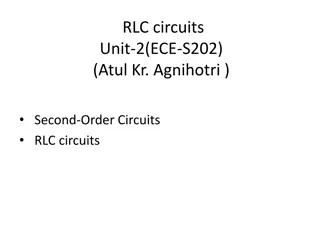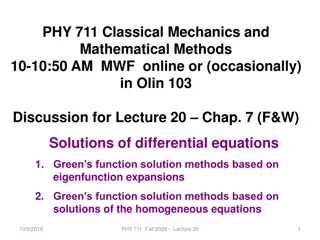Differential Equations of First Order & Higher Degree: Lecture 18
This lecture covers differential equations of first order but not of the first degree, general forms of such equations, methods for solving them, and examples of differential equations to be solved. The content includes detailed explanations, equations, solutions, and problem-solving techniques.
Download Presentation

Please find below an Image/Link to download the presentation.
The content on the website is provided AS IS for your information and personal use only. It may not be sold, licensed, or shared on other websites without obtaining consent from the author.If you encounter any issues during the download, it is possible that the publisher has removed the file from their server.
You are allowed to download the files provided on this website for personal or commercial use, subject to the condition that they are used lawfully. All files are the property of their respective owners.
The content on the website is provided AS IS for your information and personal use only. It may not be sold, licensed, or shared on other websites without obtaining consent from the author.
E N D
Presentation Transcript
Differential Equation Lecture-18 Differential Equation of the first order and higher degree UG (B.Sc., Part-2) Dr. Md. Ataur Rahman Guest Faculty Department of Mathematics M. L. Arya, College, Kasba PURNEA UNIVERSITY, PURNIA
Contents Differential equation of the first order but not of the first degree The general form of differential equation of the first order but not of the first degree i.e. the general form of differential equation of the first order and higher degree. Solution of the first order and higher degree D.E.
Differential equation of the first order but not of the first degree The general form of a differential equation of the first order and nth degree is 1 2 n n n + dy dx dy dx dy dx + + + + = 0 Q Q Q 1 2 n + + + = 1 2 n n n . . . . ie 0 ie p Q p Q p Q 1 2 n = ( , , f x y p ) 0 dy dx = , , , tan . Where p andQ Q Q Q arecons tsor functionsof xand y 1 2 3 n
Solution of the first order and higher degree D.E. Methods of solving such types of differential equations 1. Equations Solvable for p 2. Equations Solvable for y 3. Equations Solvable for x
1. Equations Solvable for p Let the general form of the differential equation of the first order and nth degree be + + + + = 1 2 n n n 0... (1) p Q p Q p Q 1 2 n Working rule:- Factorize (1) into n linear factors i.e. Equating each factor of (2) to zero, we get = = ( , ) . f x y ( , ) . f x y ( , ) f x y ( , ) f x y 0... (2) p p p p 1 2 3 n = = ( , ) f x y dy dx 0, ( , ) f x y 0, ( , ) f x y 0 p p p 1 2 2 dy dx dy dx = = = ( , ), f x y ( , ), f x y ( , ) x y f 1 2 n
Continue After integrating ,We get ( , , ) x y c = = = 0, ( , , x y c ) 0, ( , , x y c ) 0 1 1 2 2 n n Then the general solution of (1) is ( , , ) x y c c c = = = = ( , , ... = ) = ( , , ) x y c 0 x y c 1 2 n ( ) c c c say 1 2 3 n Since the equation (1) is the first order differential equation. So, the general solution of (1) contains only one arbitrary constant.
Problems Solve the following differential equations + + + + = 2 2 1. 2. 3. 2 7 2 3 0 p p p xp p py x = 2 12 cot 0 = 2 2 x y 2 + dy dx dy dx = = 4. ( ) 0 x y x y 2 x x 5. 6. ( x ) + 0 ) p p p p e + e y x = ( ) ( y
Solution Solution (1):- Given equation is + = 2 2 2 3 0 p xp + x = 2 2 3 + 3 0 = p p p p p xp xp x p x + ( 3 ) x x x ( x or p dy dx 3 ) 0 0 x + + = ( ( dy dx dy 3 )( 3 ) ) p = = 0 ( ) 0 x = = 3 x or x = = 3 xdx or dy xdx
Continue Integrating it, we get 2 2 3 2 x x x = + = + y c or y c 2 2 2 3 x + = = 0 0 y c or y c 2 3 = 2 + = = 2 2 2 0 2 0 y x k or y x k 2 wherek c Then the general solution of (1) is + = 2 2 (2 3 )(2 ) 0 y x k y x k
